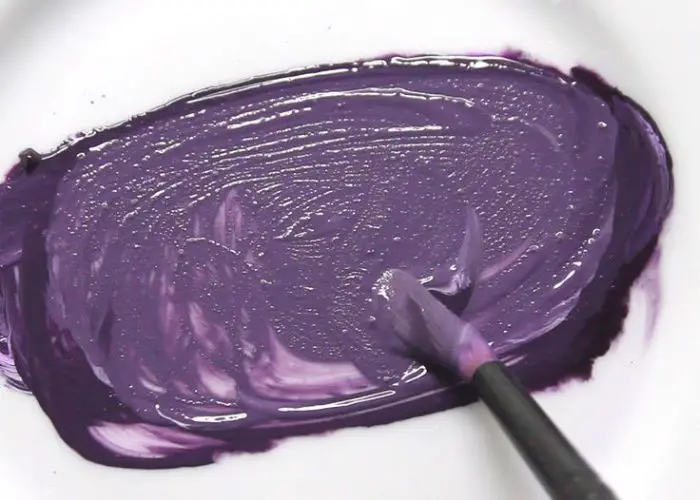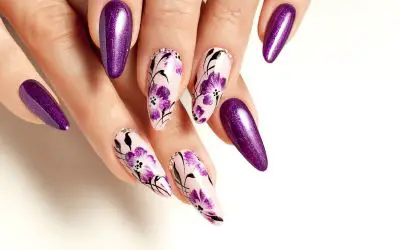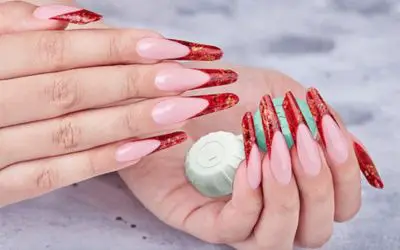Discovering a Pseudomonas nail infection can be disheartening. You may ask yourself, “Can I put nail polish over pseudomonas?”
In this blog post, I’ll take you through the debate surrounding the safety of applying nail polish over Pseudomonas.
I will explore the nature of Pseudomonas infections and risks, and provide practical advice for those faced with this dilemma.
While nail polish offers a quick fix for aesthetics, you need to understand the implications. Join me on this journey to uncover the truth behind this dilemma.
I want to make it possible for you to make informed decisions about your nail health while still expressing your personal style. Let’s begin!
Can I Put Nail Polish Over Pseudomonas?
Yes, you can put nail polish over Pseudomonas, but I do not recommend it. While nail polish may seem like a convenient solution to hide the effects of a Pseudomonas nail infection, you have to proceed with caution. Applying nail polish over an infected nail may not address the underlying issue and could worsen the infection.
What is a Pseudomonas Nail Infection aka “Greenies”?
A Pseudomonas nail infection, commonly referred to as “greenies,” is a type of bacterial infection that affects the nails.
It is caused by various strains of the bacteria Pseudomonas, particularly Pseudomonas aeruginosa.
This bacteria colonizes the nail bed and lead to an infection.
The term “greenies” comes from the characteristic green discoloration that accompanies nail infections.
The infected nails may develop a greenish hue, but they can also appear yellow, brown, or black. Other common symptoms include a foul odor, brittleness, and thickening of the affected nails.
Pseudomonas bacteria are ubiquitous and can be found in various environments, such as soil, water, and even on human skin.
Pseudomonas infections can occur in different parts of the body. These include the skin, lungs, or urinary tract. However, they commonly affect the nails.
Not all green color of the nails is Pseudomonas infection. Chemical reactions from certain nail products can also result in similar nail discoloration.
Consult a healthcare professional for an accurate diagnosis and appropriate treatment.

Can You Put Acrylic Over a Green Nail?
No, do not put acrylic over a green nail. Green discoloration in nails is often associated with Pseudomonas nail infections, which are bacterial in nature.
Doing acrylic nails over an infected nail can trap bacteria and moisture, worsen the infection and hinder the healing process.
You first need to address the underlying infection and seek treatment before applying acrylics.
Consult a healthcare professional or a nail tech to provide the best guidance for dealing with green nails.
How Do You Become Infected with the Greenies?
Pseudomonas nail infections can occur when Pseudomonas aeruginosa, colonizes the nail bed and nail plates and cause an infection. The bacteria enter the nail area through various means, including:
1. Nail trauma. Injuries or trauma to the nails, such as cuts, hangnails, or nail biting, create openings that allow bacteria to enter and establish an infection.
2. Moisture exposure. Pseudomonas bacteria thrive in moist environments. Prolonged exposure of the nails to moisture can create an ideal breeding ground for bacteria and increase the risk of infection.
3. Contaminated objects. Coming into contact with contaminated objects or surfaces that harbor Pseudomonas bacteria can introduce the bacteria to the nails. This can include shared nail tools, contaminated nail salon equipment, or unsanitary environments.
4. Compromised immune system. Individuals with weakened immune systems are more susceptible to infections. medical conditions that suppress the immune system can increase the risk of bacterial infections.
Remember, not all green discoloration of the nails is caused by Pseudomonas infections.
Other factors, such as chemical reactions from certain nail products, can also lead to similar nail discoloration.
Common Signs and Symptoms of Pseudomonas Infection in Nails
Pseudomonas nail infections can present several signs and symptoms. While the most characteristic feature is green discoloration, there are other signs and symptoms. Here are some of them:
1. Nail discoloration. The infected nail may exhibit a greenish, yellowish, brownish, or blackish color. However, you need to know the difference between greenies and other causes of nail discoloration.
2. Foul odor. Pseudomonas nail infections have a musty and foul odor emanating from the affected nails.
3. Nail brittleness. Infected nails may become brittle and prone to breaking or crumbling. The nails may appear weakened and easily damaged.
4. Thickening. Pseudomonas infections can lead to nail thickening, where the affected nails become thicker than usual. This can cause discomfort and make nail care more challenging.
5. Nail deformation. In some cases, Pseudomonas infections can cause nail deformities, such as irregular shape, ridges, or a distorted appearance.
6. Discomfort or pain. Depending on the severity of the infection, you may experience varying degrees of discomfort or pain in the affected nails. This can range from mild sensitivity to significant discomfort.
These signs and symptoms can vary from person to person. Not all individuals with Pseudomonas nail infections will experience all of these indications.
If you suspect a Pseudomonas nail infection, consult a healthcare professional for an accurate diagnosis and appropriate treatment.
They will provide the necessary guidance for managing the infection effectively.

Can I Put Nail Polish Over Pseudomonas?
While it may be tempting to cover up the visual effects of a Pseudomonas nail infection with nail polish, it is not something I recommend. Putting on polish over pseudomonas could worsen the condition.
Pseudomonas infections can cause discoloration, foul odor, brittleness, and discomfort in the nails. By applying nail polish, you may trap moisture and bacteria, which can exacerbate the infection and impede the healing process.
Prioritize proper care and hygiene when dealing with a Pseudomonas nail infection. Seek medical advice for an accurate diagnosis and appropriate treatment.
Treating the infection should be the primary focus before considering any cosmetic coverings. Address the underlying infection and follow professional guidance to promote nail health and restore the appearance of your nails.
Risks of applying nail polish over pseudomonas
Applying nail polish over a Pseudomonas nail infection poses several risks that should be considered. These risks include:
Trapping bacteria
Pseudomonas bacteria thrive in moist environments. When you apply nail polish over an infected nail, it creates a seal that can trap bacteria and moisture underneath.
This can promote bacterial growth and further exacerbate the infection.
Worsening the infection
By covering the infected nail with nail polish, you may hinder the healing process. Pseudomonas infections require proper treatment, which may involve medication or topical solutions.
Applying nail polish can interfere with the effectiveness of treatment and worsen the infection.
Delayed diagnosis
Nail polish can make it difficult for healthcare professionals to assess the condition of your nails.
If you apply nail polish over a Pseudomonas infection, it may be to diagnose the infection and determine the appropriate treatment plan.
Spreading the infection
Pseudomonas infections are contagious and can spread to other nails or even to other individuals.
Applying nail polish over an infected nail increases the risk of spreading the infection to adjacent nails or surfaces.
Masking symptoms
Nail polish can temporarily hide the visible signs of a Pseudomonas infection, such as green discoloration.
While this provides a cosmetic improvement, it can also mask the severity of the infection. This will make it difficult to monitor progress or identify potential complications.
How to Apply Nail Polish on Nail Fungus
Before applying nail polish, ensure you treat your nail fungus. After the treatment begin applying your nail polish as follows:
1. Prepare the nails. Trim your nails to the desired length and gently file the edges to create a smooth surface.
2. Apply a base coat. Apply a clear base coat to the nails. A base coat helps protect the nails from staining and provides a smooth surface for the polish to adhere to.
3. Apply nail Polish in thin, even layers. Start from the base of the nail and stroke towards the tip. Allow each layer to dry before applying the next one to prevent smudging or clumping.
4. Apply additional layers (Optional) if you prefer a more opaque look or want to enhance the color intensity.
5. Once the desired color is achieved, finish with a clear top coat. The top coat adds shine to the nails, protects the polish from chipping, and prolongs its wear.
6. After applying the top coat, allow your nails to dry. This may take a few minutes to ensure that the polish is completely set and won’t smudge or get damaged.
How to Apply Press-on Nails to Avoid Green Nails Syndrome?
To apply press-on nails and minimize the risk of developing “green nails syndrome follow these guidelines:
Step 1: Clean and prepare your nails. Clean your natural nails thoroughly. Remove any existing nail polish and push back your cuticles. Trim and shape your nails to your desired length.
Step 2: Sanitize your hands and tools. Wash your hands with soap and water. Sanitize your tools, including cuticle pushers and nail clippers.
Step 3: Choose quality press-on nails. Opt for high-quality press-on nails from reputable brands. Look for products made of safe materials and have a secure adhesive backing.
Step 4: Proper nail preparation. Before applying the press-on nails, buff the surface of your natural nails using a fine-grit nail buffer. This helps create a rough texture, allowing better adhesion for the press-on nails.
Step 5: Follow the manufacturer’s instructions. Each brand may have specific application techniques and adhesive recommendations.
Step 6: Apply adhesive properly. Use the adhesive provided with the press-on nails or a nail glue recommended by the manufacturer. Apply a thin, even layer of adhesive onto your natural nail, ensuring it covers the entire surface.
Step 7: Press-on nail application. Carefully align the press-on nail with your natural nail, starting from the cuticle area and pressing it down firmly. Hold the press-on nail in place for a few seconds to allow the adhesive to bond effectively.
Step 8: Trim and shape. Once you have applied the press on nails, trim and shape them to your desired length and style using a nail file or nail clippers. Be cautious not to apply excessive pressure that might damage your natural nails.
Step 9: Regular maintenance. If you decide to keep the press-on nails for an extended period, make sure to maintain good nail hygiene. Keep your nails clean, dry, and avoid prolonged exposure to moisture.
Step 10: Timely removal. Remove the press-on nails if you notice any signs of infection or irritation. Consult a healthcare professional if your natural nails show any unusual signs.
How Do You Treat Green Nails?
Treating green nails involves addressing the underlying infection and promoting nail health. Here are some common approaches for treating green nails:
1. Consult a healthcare professional
Seek help from a medical practitioner. They will assess the severity of the infection and provide personalized recommendations.
2. Proper nail care
Practicing good nail hygiene is crucial for managing green nails. Keep your nails clean and dry, and avoid any activities that may worsen the infection or cause further trauma to the nails. Trim your nails regularly and gently, ensuring not to cut too close to the skin.
3. Antibacterial treatment
Depending on the severity of the infection, you will use topical or oral antibiotics. Follow the prescribed dosage and application instructions as directed by your healthcare professional.
4. Topical antiseptics
Your healthcare professional may recommend the use of topical antiseptics. These may include antiseptic solutions, ointments, or creams designed for nail infections.
5. Nail debridement
In some cases, your healthcare professional may need to remove any infected or damaged portions of the nail. This can help improve the effectiveness of topical treatments and allow for better penetration of medications.
6. Avoid nail polish
Avoid applying nail polish over green nails. Nail polish can trap moisture and bacteria and worsen the infection. Allow your nails to breathe and heal properly.
7. Address underlying causes
Identify and address any underlying factors that contribute to the infection.
Is there a home remedy for green nails?
Yes, there are home remedies for managing green nails. Unfortunately, they may not be as effective as medical treatments.
They may provide temporary relief or help improve the appearance of the nails. Here are a few home remedies that may help you:
- Soak the affected nails in a solution of equal parts water and vinegar for about 15-20 minutes daily. Vinegar has antimicrobial properties that could help inhibit the growth of bacteria.
- Apply tea tree oil directly to the affected nails.
- Hydrogen peroxide is also a good disinfectant for green nails. However, it may also cause skin irritation or damage if not used properly.
- Practice proper nail hygiene regardless of the specific remedies used. Keep your nails clean, dry completely, and well-trimmed.

How Do You Prevent the Green Nail Syndrome?
Preventing green nail syndrome involves practicing good nail hygiene. Other preventive measures to consider:
1. Maintain good nail hygiene. Always keep your nails clean and dry.
2. Trim your nails regularly and keep them at a manageable length. Avoid cutting the nails too short or aggressively pushing back the nail plate, as this can create openings for bacteria to enter.
3. Minimize activities that may traumatize or injure the nails, such as biting your nails or using them as tools.
4. Avoid excessive moisture as Pseudomonas bacteria thrive in moist environments. Wear gloves when doing dishes, laundry, or even gardening.
5. Choose shoes that allow for adequate ventilation and moisture control. Opt for breathable materials and avoid tight or ill-fitting shoes that can create a damp environment.
6. Avoid sharing nail tools such as nail clippers, and files. Use your own tools and avoid sharing them with others to prevent the spread of bacteria.
7. Regularly clean and disinfect your nail tools to prevent the buildup of bacteria. Use rubbing alcohol or an appropriate disinfectant to sanitize your tools after each use.
8. If you have a nail infection or suspect a Pseudomonas infection, avoid applying nail polish over the affected nails.
9. If you notice any signs of nail infection, such as green discoloration, foul odor, or discomfort, seek medical attention. Early diagnosis and treatment can help prevent the progression of the infection.
Proper Management of Pseudomonas Infection
Here are some general guidelines for managing nail fungus:
Consult a healthcare professional
A healthcare professional will give you an accurate diagnosis and appropriate treatment plan. They can assess the severity of the infection and provide suitable recommendations.
Antifungal medications
Topical or oral antifungal medications may treat nail fungus. Follow the healthcare professional’s instructions on how to apply or take the medication.
Nail care
Practicing proper care is crucial for managing nail fungus. Keep your nails clean and dry, and regularly trim them to maintain a shorter length.
Avoid sharing nail tools to prevent the spread of the infection.
Good foot hygiene
Practice good foot hygiene to reduce the risk of reinfection. Wash your feet regularly, especially between the toes, and dry them afterward. Wear clean socks made of breathable materials and change them frequently.
Choose proper footwear
Opt for shoes that allow proper ventilation and moisture control. Avoid tight or narrow shoes that can create a damp environment, promoting fungal growth.
If possible, alternate your footwear to allow them to dry out completely between uses.
Treat infected shoes
Fungal spores can reside in shoes, leading to reinfection. Use antifungal sprays or powders inside your shoes to help eliminate any lingering fungus.
Note: Follow the advice of a healthcare professional for treating nail fungus effectively. They can provide personalized guidance based on the severity of the infection and your specific needs.
Alternatives to Nail Polish During Infection
During a nail infection, I would not recommend using regular nail polish. Fortunately, there are alternative options to consider.
These alternatives will help maintain nail health and appearance while supporting the recovery process.
Using clear nail strengtheners or treatments
Apply clear nail strengtheners or treatments instead of colored nail polish. These products improve the strength and condition of the nails, promoting healthier growth.
Exploring non-toxic or natural nail care options
Explore non-toxic or natural nail care options that are free from harmful chemicals. There are brands that offer nail polishes, nail enhancements, treatments, and topcoats made with safer and more natural ingredients.
These alternatives minimize exposure to harsh chemicals while still providing a polished appearance.
Embracing natural nail appearance and focusing on recovery
During the infection and recovery period, embrace your natural nails. Allow them to breathe and recover without any polish or treatments.
By avoiding nail polish altogether, you eliminate the risk of trapping bacteria or hindering the healing process. Prioritize nail recovery and focus on getting healthy nails.
FAQs
Do press-on nails cause green nails?
No, press-on nails do not cause green nails. Green nails are caused by the presence of the Pseudomonas bacteria. These bacteria can enter the nails through various means, such as trauma, exposure to contaminated water, or poor nail hygiene.
How to get rid of green spots under acrylic nail
Gently remove the acrylic nail to expose the affected area and clean it with gentle antibacterial soap and warm water. Soak the nail in a solution of equal parts water and vinegar for 15-20 minutes daily. Apply diluted essential oils, and use an antifungal cream like clotrimazole.
Is pseudomonas contagious on nails?
No, Pseudomonas infections on nails are not contagious. Pseudomonas bacteria are opportunistic pathogens that reside in the environment. They can enter the nails through various means, such as trauma or exposure to contaminated water. Once inside the nail, the bacteria can cause an infection, resulting in green discoloration and other symptoms.
How to get rid of green nails after fake nails
To get rid of green nails after wearing artificial nails, remove the false nails using acetone nail polish remover or soak them in warm water. Clean your natural nails with gentle antibacterial soap and warm water to remove any residue or bacteria. Trim and file your nails to a shorter length, then soak them in a solution of equal parts water and vinegar for 15-20 minutes to inhibit bacterial growth. After drying your nails, apply a diluted solution of tea tree oil or an antifungal cream.
Can you put a fake nail on skin?
Yes, you can put a fake nail on damaged nails but I do not recommend it. Fake nails should only be applied to the natural nail or nail tips to create extensions. Applying fake nails on the skin can lead to discomfort, pain, and potential skin irritation or damage.
Conclusion
Whether or not to put nail polish over a Pseudomonas infection, is a decision that requires careful consideration.
While you may be tempted to cover up the appearance, prioritize your nail health and the proper treatment of the underlying infection.
Remember, Pseudomonas nail infections are not just cosmetic issues. They can cause discomfort, damage to the nails, and potential complications if left untreated.
An artificial nail may trap moisture, hinder the healing process, and even exacerbate the condition.
Instead, focus on addressing the infection itself. Seek professional advice and prioritize your overall nail health over temporary cosmetic solutions.
Embrace the journey of healing and recovery, and remember that healthy nails are beautiful nails.










Leave a Reply